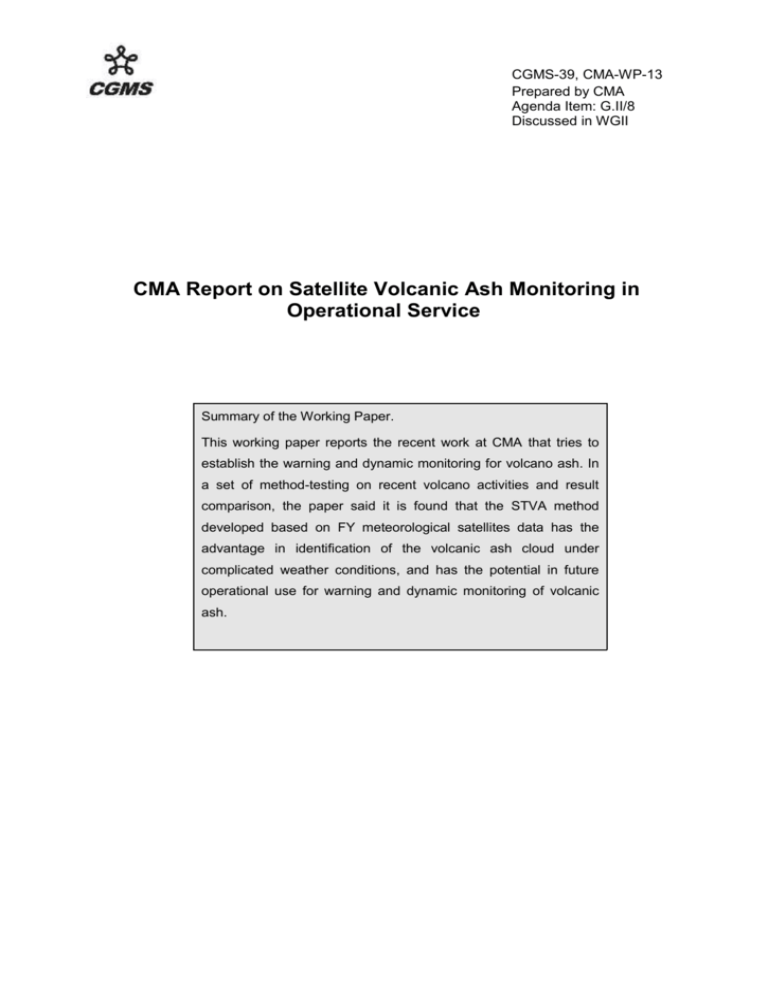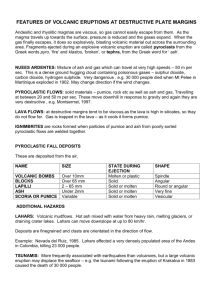4. Conclusion
advertisement

CGMS-39, CMA-WP-13 Prepared by CMA Agenda Item: G.II/8 Discussed in WGII CMA Report on Satellite Volcanic Ash Monitoring in Operational Service Summary of the Working Paper. This working paper reports the recent work at CMA that tries to establish the warning and dynamic monitoring for volcano ash. In a set of method-testing on recent volcano activities and result comparison, the paper said it is found that the STVA method developed based on FY meteorological satellites data has the advantage in identification of the volcanic ash cloud under complicated weather conditions, and has the potential in future operational use for warning and dynamic monitoring of volcanic ash. CGMS-39, CMA-WP-13 CMA Report on Satellite Volcanic Ash Monitoring in Operational Service 1. Introduction Volcanic ash is one of the concerns for the safety of aviation, and has long-term impact on climate and the earth environment. It is necessary to establish a way for global monitoring and warning the volcano ash. This paper introduces the recent work at the China Meteorological Administration (CMA) on volcanic ash monitoring using the FY series meteorological satellite data. The key points in our present work include (1) “hot spot” detection for warnings of volcanic eruption, and (2) volcanic ash detection. 2. “Hot Spot” Detection At the early stage of volcanic eruption, large volume of rock-magma and other hot material up welling through the volcanic conduit make abnormally high surface temperature on the satellite images compared with other objects nearby. The mid-infrared sensors respond strongly to the thermal emission of magma surface even though the area is very small in the view of satellite. Based on this fact, the mid-infrared bands of geostationary satellite FY-2 and polar-orbiting satellite FY-3 can find their use in detecting the volcanic eruption. Especially, the polar-orbit satellite FY-3 is used to detect the hotspot and it has higher spatial resolution of resolution of 250m. 3. Volcanic Ash Detection Currently, there are three methods to use the satellite data in monitoring the range and move of volcanic ash, namely, the “ultraviolet radiation absorption method”, the “pattern recognition method” based on visible and infrared data, and the “split window temperature difference method (SWTD)” based on thermal infrared data. The SWTD method is commonly considered to be an automatic and quantitative tool to detect volcanic ash. We are developing the volcanic ash cloud detecting method (SWIR-TIR Volcanic Ash method, or STVA) at CMA that uses the images of Medium Resolution Spectral Imager (MERSI) and Visible and Infrared Radiometer (VIRR) on board FY-3A. The STVA is expected to improve the performance of SWTD under complicated weather conditions. In Figure 1, a large meteorological cloud cover (the temperature less than 250 K indicating the altitude is high) is considered as volcanic ash cloud by the SWTD method. SWTD also has false alarm on Iceland’s surface covered with ice and snow. Page 1 of 3 CGMS-39, CMA-WP-13 Figure1. Volcanic ash cloud detected by SWTD method based on FY-3A/MERSI thermal channels (on April 19, 2010 at 12: 45 UTC). Compared with SWTD, the STVA performance is improved that extracts the volcanic ash information from the complex meteorological conditions. The mis-classification ratio of STVA is considerably reduced (Figure 2). Figure 2. Volcanic ash cloud detected by STVA method by combination of FY3A/MERSI shortwave bands and FY-3A/VIRR thermal bands (on April 19, 2010 at 12: 45 UTC) Page 2 of 3 CGMS-39, CMA-WP-13 4. Conclusion Establishing the warning and dynamic monitoring for volcano ash is important both for aviation safety and climate change study, the FY meteorological satellites data has certain advantage in this regard and we have made investigations on recent volcanic activities, tested a set of methods in order to find the best way for early warning and dynamic monitoring of volcanic ash. The preliminary result shows that the STVA method based on FY-3A satellite data is effective in complicated meteorological conditions and has potential in future operation for monitoring global volcanic ash cloud. Page 3 of 3







